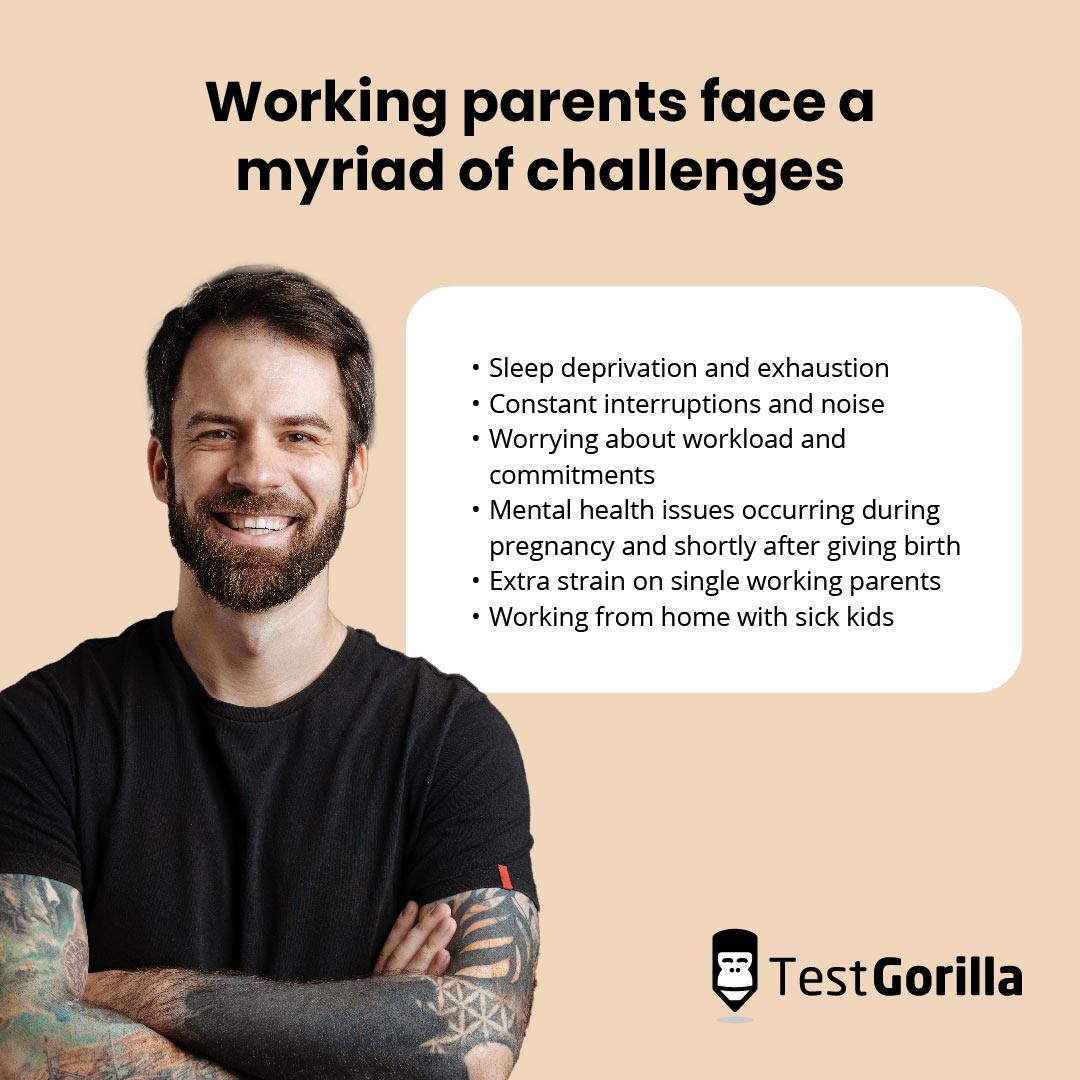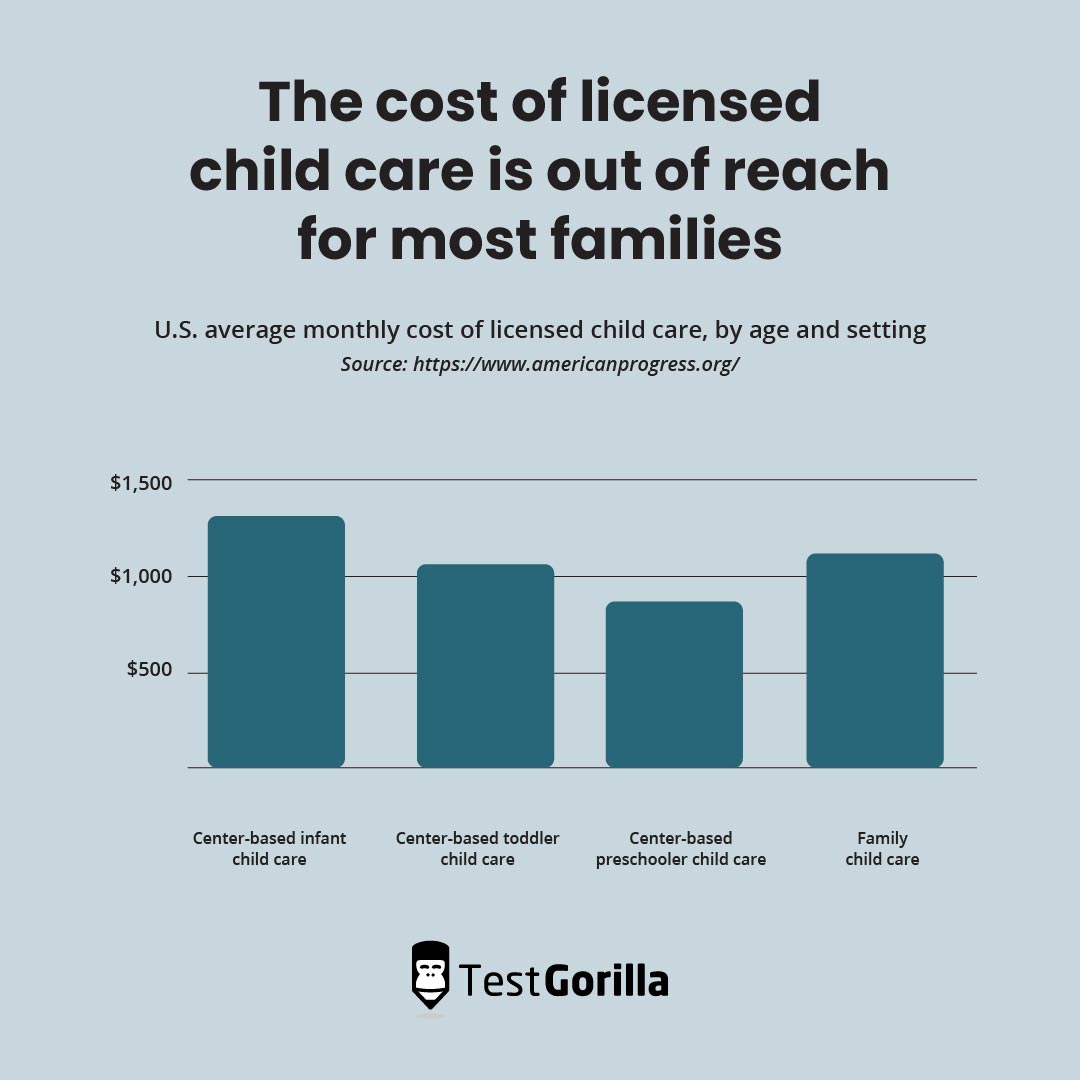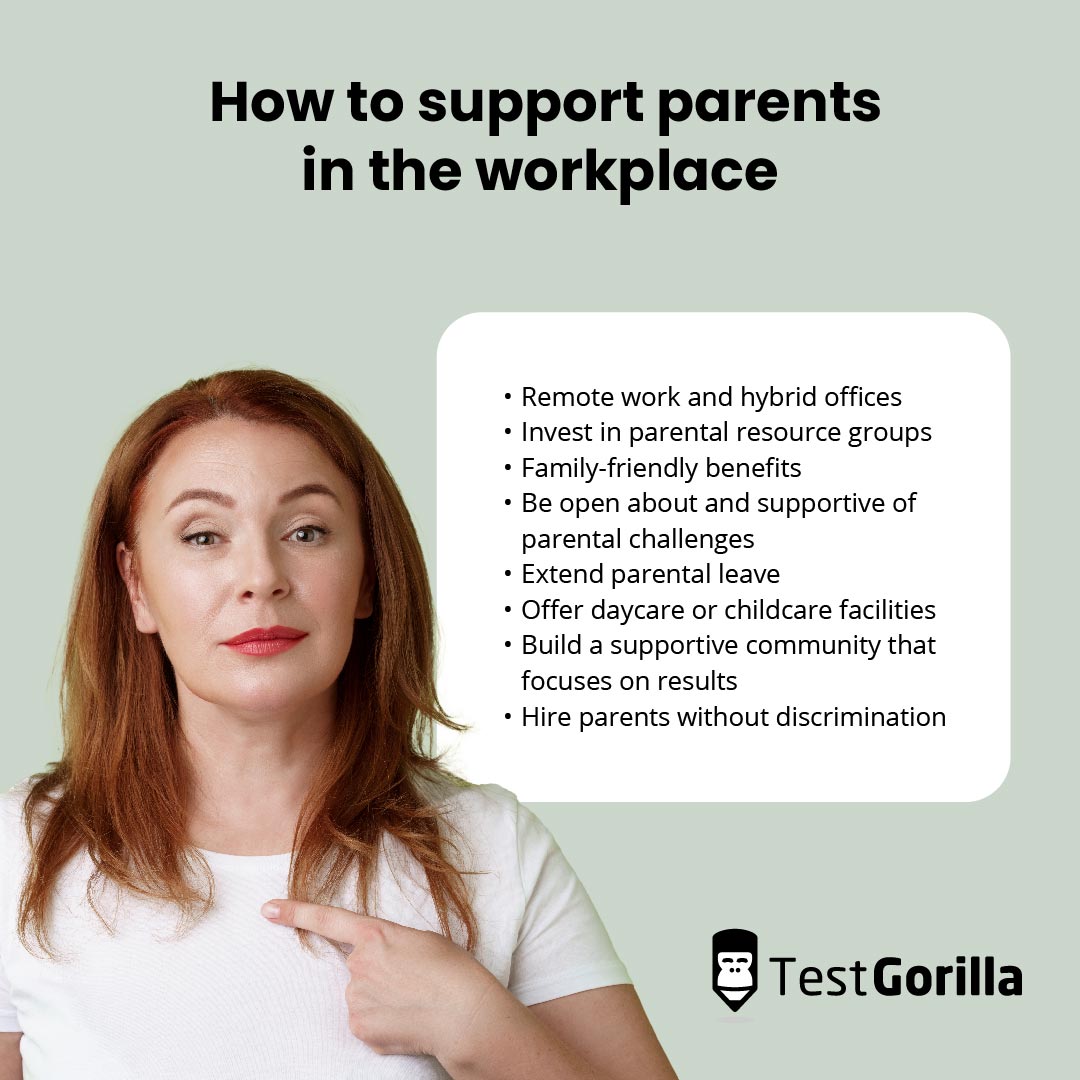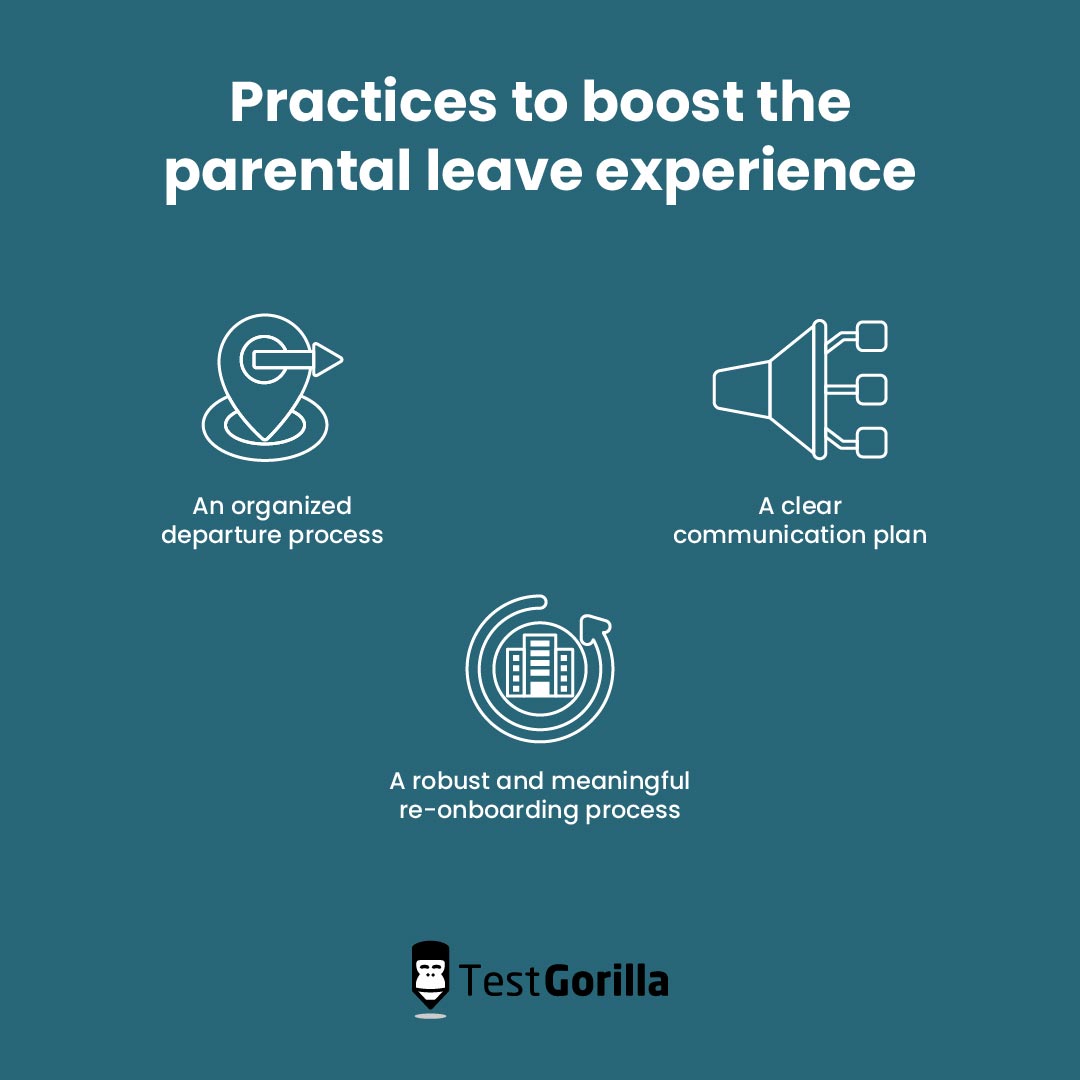Extremely talented individuals may leave your company, but not by choice.
When an organization doesn’t provide for working parents, it neglects the needs of 40% of the working population.[1]
Supporting working parents means providing your employees with the time off and the flexibility to stay in their roles while supporting their growing families.
It’s a win for parents, who can balance their job with their children. It’s a win for children, whose parents are more present with them.
And it’s a win for employers, who retain some of their best employees (many parents have excellent situational judgment skills!) and minimize the cost of having to rehire every time a stellar staff member becomes a parent.
So how can you support working parents, and what are the far-reaching benefits of doing so?
This article discusses the many challenges working parents face and why supporting them is important. It also describes the eight strategies your organization can adopt to help parents in the workplace.
Table of contents
What challenges do working parents face?
Working parents face many challenges due to their double commitment: their children and their job.
Caring for children while keeping up with the demand of work is a strain on physical, emotional, and mental health. In a study on healthcare workers, childcare stress was associated with an 80% higher chance of burnout.
Working parents face a myriad of challenges:
Sleep deprivation and exhaustion
Constant interruptions and noise
Worrying about workload and commitments
Mental health issues occurring during pregnancy and shortly after giving birth
Extra strain on single working parents
Working from home with sick kids
One of working parents’ largest issues is financial well-being, particularly when it comes to childcare.
Childcare costs in the US can exceed $1,300 per month.
The concept of working parents is fairly new since traditional gender roles and family structures have been changing in recent times.
Modern society has redefined the traditional familial structure. This is a wonderful thing, but it also brings challenges as parents decide what they want their family and work-life balance to look like.
If parents, or aspiring parents, aren’t supported to achieve a healthy balance between their personal lives and work, they face a brand-new, even worse challenge: deciding whether to quit their job, neglect their family, or not have children altogether.
Why you should support working parents
According to the Bureau of Labor Statistics, more than 75% of mothers and 95% of fathers work full-time.
Our society benefits from this liberation. However, to continue seeing this new world flourish, we have to provide better support for parents.
Accepting, destigmatizing, and supporting working parents brings numerous benefits to the workplace.
Parents bring unique viewpoints and skill sets, such as increased motivation, time management skills, conflict resolution, and communication.
You stand to gain a wealth of diverse priorities, skills, and perceptions when you incorporate working parents and people without children into your workforce.
According to a 2020 study, organizations that invest in employees and their families have 5.5 times more revenue growth thanks to greater innovation, higher talent retention, and increased productivity.
Supporting parents in the workplace also widens your talent pool. If you only support those who work the traditional nine to five, you’re eliminating candidates who need to consider:
Childcare
School drop-offs and pickups
Caring for children with medical needs or disabilities
The most important consideration is that supporting working parents is simply the right thing to do and should be normalized.
Employees are people. They have lives, priorities, and meaningful responsibilities outside work. They have life goals and aspirations.
Showing awareness of their lifestyle, needs, and challenges enables them to come to work happier and more productive.
Plus, the more you do this, the more you’ll attract top talent who will see the benefit of working for a company that fosters a culture of respect and support.
How to support parents in the workplace: 8 strategies
So how can your business support working parents?
There are two main types of support you can give to parents:
Alter your work structure: Create a solid framework and structure to help parents do their jobs
Shift your worldview: Nurture a culture that accepts parents and their responsibilities
Each of our eight strategies falls under one of these two main categories. Here they are in summary:
Strategy | Description |
1. Remote work and hybrid offices | Flexible, hybrid work environments help parents get work done when they’re most productive |
2. Invest in parental resource groups | Employee resource groups can enable parents to support each other |
3. Family-friendly benefits | Certain benefits, such as childcare and time off, are essential for working parents |
4. Be open about and supportive of parental challenges | Communicate with your employees who are parents, and encourage them to talk about their challenges |
5. Extend parental leave | Implement a solid parental leave program, including easing them back into work when they return |
6. Offer daycare or childcare facilities | Onsite childcare facilities give crucial support to working parents, boosting productivity and engagement |
7. Build a supportive community that focuses on results | Foster a company culture that prioritizes results over hours worked |
8. Hire parents without discrimination | Use a bias-free hiring method like skills testing to assess the capabilities of candidates who are parents |
Let’s discuss these strategies in full.
1. Remote work and hybrid offices
Remote work and hybrid offices are great for working parents, providing them with a host of benefits:
Increased flexibility
The ability to have more time at home with their children
Less money spent on childcare and other costs, like transportation
The chance to choose their living area based on economic needs and proximity to local schools, family, and friends, as opposed to distance from the office
Adopting a flexible working policy to better support parents also has advantages for your organization.
A hybrid work environment empowers employees with children to work when they’re feeling most productive and energetic – not when they’re torn between two things or feel like they’re missing out on a special moment with their child.
This translates to better performance, meaning your company will get more value and high-quality work from them.
Here’s a real-world example of the consequences of not offering a flexible or remote work environment:
In a post by Forbes, Heather Odendaal, the chief executive officer and co-founder of WNORTH, discusses her experience juggling inflexible work and being a new mother.
When she returned from maternity leave, Odendaal worked five days a week versus the four days she worked before leaving. She found herself following a schedule suited to her predecessor, and her sales territory was now triple the size.
She was driving up to 14 hours a day, only to have to return and still provide care for her baby.
Odendaal presented her case, requested a flexible work environment, and was denied – so she quit and started her own business.
She summarizes her story by stating that if she hadn’t been forced into a rigid five-days-a-week corporate workplace, she could’ve brought real value to the business.
Adopting a flexible working policy is crucial for your employees with children, but this practice will also benefit you if you strive for quality work and high employee retention.
2. Invest in parental resource groups
Employee resource groups are voluntary, employee-led communities that offer personal and professional support to a variety of groups.
These groups can be invaluable for many marginalized individuals, particularly groups based on ethnicity, gender identity, religious beliefs, or lifestyle.
Employee parent resource groups are on the rise, enabling working parents to talk with other working parents who have experienced similar challenges and stress.
It can be a life-saver to get solid advice from other parents as you take on the challenges of balancing parenthood and work responsibilities, like organizing childcare schedules, managing sick days, and meeting work expectations.
3. Family-friendly benefits
Suitable family-friendly benefits are a huge factor in retaining working parents, but they’re also important in attracting talent.
Many parents have to turn down an employment offer because it doesn’t come with benefits and support for their family.
These benefits might include:
Benefit | Description |
A flexible paid time off policy | This could include extra time off or sick hours (as well as days) to better customize a busy schedule |
Funds for daycare | Offering easy access to a childcare assistance program |
Self-care items | Supporting a parent’s wellness with movie tickets, dinner vouchers, or gym memberships |
Food delivery and grocery vouchers | Helping busy parents provide healthy meals for their family |
Your company benefits and swag may already include some of these.
Healthcare and dependent care are also vital financial support for working parents, and a lot of your top talent will be on the lookout for them as they search for jobs.
A parent who doesn’t receive a fair amount of paid time off, childcare assistance, and time for themselves will end up stressed, burned out, and disengaged.
Providing these key benefits to your employees alleviates some of their challenges, reduces stress, and increases their energy and productivity.
4. Be open about (and supportive of) parental challenges
Parenthood is, for many people, an essential part of life. Unfortunately, it’s still stigmatized in the workplace. Many feel apprehensive about sharing their difficulties and challenges as working parents.
Keeping quiet about these issues only leads to more stress and inhibited performance – and child-free colleagues won’t understand why.
A great way to center workplace culture around parenthood is to be more open about parental challenges in one-to-one coaching sessions and offer whatever support you can.
This isn’t only about the support you can give through your organization’s resources but also the power you have to destigmatize these conversations and improve your company culture as a whole.
Employers should lead from the top and start to normalize open communication for parents facing issues and stress.
Charlotte Speak, the chief executive officer of Power of the Parent, has some great suggestions on how to connect with employees who are parents.
She says all you need to start is empathy, compassion, and the ability to listen. You may not understand what they’re going through from personal experience, but your empathy could mean the world to them.
Charlotte also recommends some great questions for your one-to-ones:
“How does it feel to be a parent here?”
“Where are the gaps in support?”
“What has been the most helpful kind of support?”
“What assumptions are we making about you (and other parents)?”
One-to-one coaching sessions are critical for supporting employee performance, growth, and satisfaction. They involve discussing what challenges employees face and what impacts their work.
A working parent’s family life can’t help but directly impact their performance, productivity, and work in general – so it should be an open topic of discussion in a one-to-one.
If you employ new parents who are struggling to cope with their work-life balance, you can go further and offer professional support in the form of traditional and digital therapy.
5. Extend parental leave
Extend maternal and paternal leave periods, and give parents the time they need to return at their best.
Your employees need to take time off to welcome their new baby, recover, and adjust to their new life together – then return to work. Offering limited or no parental leave often forces a worker to quit when they otherwise would have stayed.
Even businesses that give maternal and paternal leave may have stifling requirements when a parent returns to work, which is exactly what happened with Heather Odendaal in our above story.
Here are a few practices you can put in place to boost the parental leave experience:
An organized departure process
A clear communication plan
A robust and meaningful re-onboarding process
These processes enable a smooth departure and return. You don’t want parents abruptly disconnecting from the workplace because that could make re-entering difficult for them and the rest of the team.
6. Offer daycare or childcare facilities
Childcare support via an onsite childcare facility can be a huge relief for employees with children.
Daycare isn’t just expensive but also difficult to arrange. Juggling pickup times is a headache for most parents and can be even harder for single parents.
For parents with children in school, company-hosted childcare can be especially useful over the summer holidays.
This type of support can reduce stress, boost productivity, and provide crucial financial support for working parents.
Outdoor clothing company Patagonia adopted onsite childcare to support its employees as a part of what it calls “family-affirming policies,” which include extended maternal and paternal leave.
To use this childcare facility, employees pay only 70% to 75% of the cost – and every penny saved is a relief to hardworking parents.
Parents benefit from being able to visit their children during lunch hours, which also means that nursing mothers have the option to breastfeed their infants during breaks.
Here are the effects the organization saw after adopting this practice:
Tax benefits enable the business to recoup around 30% of the childcare costs
Another 30% of the costs are absorbed by regained productivity, reduced turnover, and the subsequently reduced recruitment, relocation, and training costs
An additional 11% of the costs are offset by enhanced employee engagement and higher quality of work
Employees enrolled in the program have 25% lower turnover than the company’s general employee population
Dean Carter, the chief human resources officer at Patagonia, says he considers childcare a bedrock employee benefit, like healthcare and time off.
Patagonia isn’t alone, either – a handful of other prominent companies offer similar care, such as Disney, Home Depot, Clif Bar, and Procter & Gamble.
7. Build a supportive company culture that focuses on results
Cultivating and nurturing a results-oriented work culture is one of the top ways to support working parents.
Too many businesses look at the hours clocked rather than the effort expended and the results achieved. Parents may need extra time off work, but if they complete their work satisfactorily, why should it matter?
Shifting your organization’s mindset to focus on results versus hours worked helps create a more comfortable work environment for everyone. One of the best ways to get started is by leading from the top.
When a leader adopts a practice, it sets a visible example for their staff, and supporting family needs is no different.
A great example is Parag Agrawal, the chief executive officer of Twitter, who made headlines earlier this year when he took several weeks of paternity leave.
A male chief executive officer of such a huge company taking parental leave sent shockwaves through the business world, particularly for men.
The response from male professionals was overwhelming. Ned Segal, Twitter’s chief financial officer, thanked Agrawal and said that he wished leaders had made meaningful moves like this when he first became a father.
Another response came from Jimmy Moock, a partner at a PR firm in Philadelphia, who celebrated Agrawal leading by example and recalled the guilt he felt when he took time off following the birth of his daughters.
A results-oriented, family-friendly company culture is much easier to foster when leaders such as supervisors, chief executive officers, and managers take the initiative and lead by example.
Employees will feel more comfortable taking time off for their families if they see a leader doing it – and employees without children will feel more comfortable about their colleagues taking family time off, too.
8. Hire parents without discrimination
Recruiters can have a conscious or unconscious bias against parents, new parents, and parents-to-be. They may discriminate against these candidates by assuming they’re not a good fit.
The stigma attached to working parents could be affecting your recruitment process, and letting it cloud your judgment could prevent you from finding an ideal hire.
Adopting bias-free hiring practices, like pre-employment skills testing, can reduce this risk. (It can also help attract talent who would otherwise be put off.)
Online skills testing ensures a candidate has the right skills to succeed in the role so that you can evaluate them based on their capabilities rather than their personal lives.
The following are just a few skills tests you can include in a skills assessment:
You may even find that a candidate excels at these skills because they are a parent since raising a child builds many transferable skills and experiences.
Discriminating against parents rules out a huge portion of the workforce with valuable talents, skills, and life experience.
It’s time to shift our worldview to understand that top talent can also be mothers and fathers – and we can start here.
Supporting parents in the workplace benefits employees and companies alike
It’s critical to implement workplace practices that recognize the changing realities of modern families. Providing aid to working parents enables them to do their best work, which brings a host of benefits.
Offering childcare, hybrid offices, and extended parental leave helps reduce parenting stress. As a result, you reduce turnover, boost productivity, and save thousands of dollars in costs.
Above all, remember that behind these statistics are real people who love their children, and they deserve your support and respect.
Being a solid employer means uplifting your employees where possible so that they can live their lives and accomplish their goals to the best of their ability.
To learn more about hiring and supporting candidates based on their skills and capabilities, read our article on skills-based hiring practices.
And the next time you evaluate a working parent candidate, try adding our Time Management test to their assessment. (Time management is something most parents are ridiculously good at.) Try TestGorilla for free.
Source:
“Seven insights on investing in working families now and moving forward.” (August 13, 2021). Cleo. Retrieved October 13, 2022.
Related posts
Hire the best candidates with TestGorilla
Create pre-employment assessments in minutes to screen candidates, save time, and hire the best talent.
Latest posts
The best advice in pre-employment testing, in your inbox.
No spam. Unsubscribe at any time.

Hire the best. No bias. No stress.
Our screening tests identify the best candidates and make your hiring decisions faster, easier, and bias-free.
Free resources
This checklist covers key features you should look for when choosing a skills testing platform
This resource will help you develop an onboarding checklist for new hires.
How to assess your candidates' attention to detail.
Learn how to get human resources certified through HRCI or SHRM.
Learn how you can improve the level of talent at your company.
Learn how CapitalT reduced hiring bias with online skills assessments.
Learn how to make the resume process more efficient and more effective.
Improve your hiring strategy with these 7 critical recruitment metrics.
Learn how Sukhi decreased time spent reviewing resumes by 83%!
Hire more efficiently with these hacks that 99% of recruiters aren't using.
Make a business case for diversity and inclusion initiatives with this data.























